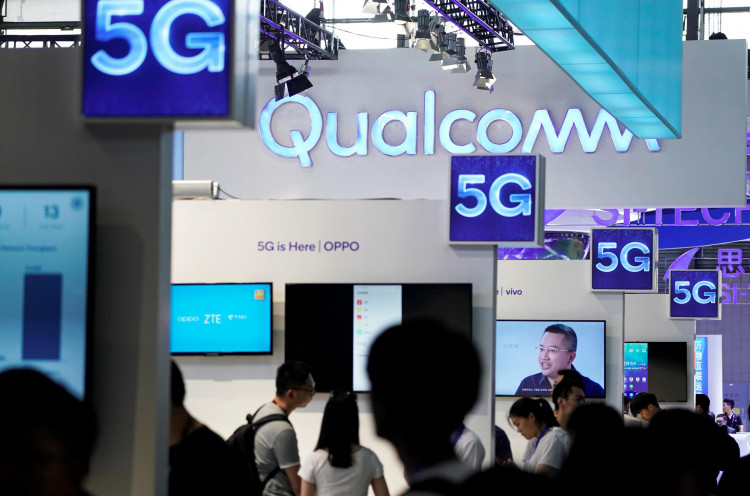Apple has long sought to develop its own 5G baseband chips to reduce its reliance on Qualcomm. However, the launch of the iPhone 15 series has underscored that Apple still grapples with Qualcomm's dominant position in the 5G chip market.
On September 13, Apple announced that the iPhone 15 Pro and 15 Pro Max would feature the A17 Pro chip, the industry's first commercially available 3nm process chip. Yet, there was no significant advancement in 5G baseband technology.
Just two days prior, on September 11, Qualcomm revealed an agreement to supply Apple with Snapdragon 5G modems and RF systems for smartphones launching between 2024 and 2026. This suggests that Apple's journey to self-reliance in baseband technology is facing hurdles, and the tech giant will remain dependent on Qualcomm for the foreseeable future.
Sources familiar with the matter indicated that Apple tested its self-developed 5G baseband chip late last year. The results showed it lagged behind Qualcomm's technology by about three years. This would render iPhones unable to compete in terms of internet speed. Consequently, Apple abandoned plans to use this chip in 2023 models, initially pushing the launch to 2024 before realizing even that timeline might be unattainable.
Insiders believe Apple's struggles with 5G baseband chip development are self-inflicted. Technical challenges, communication breakdowns, and internal disagreements over whether to pursue in-house development have slowed progress. Additionally, teams in the U.S. and abroad operated in silos, lacking a global leader to oversee the entire project. Some regional chip development managers even prevented engineers from sharing bad news about delays, leading to repeatedly missed deadlines.
Investors had hoped that Apple could reduce costs by developing its chips, especially as smartphone market demand wanes. In 2022, Apple paid Qualcomm over $7.2 billion in patent fees. However, the complexity of baseband chips, which need to be compatible with previous communication technologies and have a comprehensive patent layout, makes in-house development challenging.
As Jaydeep Ranade, Apple's former head of mobile business, pointed out, it's naive to think that just because Apple produces the best chips, they can also manufacture baseband chips.
Challenges in Modem Chip Development
To lessen its dependence on Qualcomm, Apple began collaborating with Intel on the iPhone 7 series in 2016. By 2018, Apple CEO Tim Cook had ordered the design and manufacture of modem chips, hiring thousands of engineers to achieve this goal.
In late July 2019, Apple announced the acquisition of Intel's smartphone modem and baseband chip division, aiming to create its 5G modems and baseband chips.
This dual strategy of purchasing Qualcomm products while secretly developing alternatives is a classic Apple move and part of Cook's supply chain management approach. However, Apple's progress in developing its 5G baseband chip hasn't met expectations, leaving the iPhone's baseband and RF chips still at Qualcomm's mercy.
Former Apple engineers and executives revealed that the company initially planned to use its modem chip in the latest iPhone models. However, tests conducted last year found the chip to be too slow, prone to overheating, and too large, occupying half the space of an iPhone, rendering it unusable.
Apple believed it could replicate its success in designing microprocessor chips for the iPhone. However, they soon realized that the technical requirements for baseband chips are exceptionally high. The challenges encompass various aspects, including patent issues, balancing power consumption, speed, cost, and even new technical requirements like satellite communication.
The primary challenges can be viewed from vertical and horizontal perspectives. Vertically, baseband chips must support 5G while also being backward compatible with 4G, 3G, and 2G standards. Horizontally, they must support global network standards, meet the requirements of different global carriers, and undergo comprehensive field testing. Most current smartphone baseband chip suppliers have been accumulating technology and patents since the 2G era.
Apple's Urgent Need to Break Free from Qualcomm
The patent dispute between Apple and Qualcomm is not new. According to Qualcomm's agreement, for every iPhone sold, Apple must pay Qualcomm 5% of the sale price as a patent licensing fee, colloquially termed the "Qualcomm tax."
As iPhone prices have soared, Qualcomm's patent licensing fees have risen proportionally, growing from $7.5 per device to between $12 and $20 per device. In 2022, Apple's "Qualcomm tax" reached $9 billion, accounting for one-fifth of Qualcomm's revenue.
In recent years, Apple has grown increasingly discontented with Qualcomm's patent licensing model, leading to escalating disputes between the two tech giants.
The tension peaked in 2019. On one hand, Qualcomm accused Apple of infringing on its patents by withholding patent fees and alleged that Apple deceived regulators worldwide and stole software to assist other chip manufacturers. On the other hand, Apple argued that Qualcomm, as a monopoly, had been charging exorbitant patent fees for years. Cook internally criticized Qualcomm's licensing fee model as fundamentally flawed.
However, the two companies eventually settled. In April 2019, Apple announced a six-year licensing agreement with Qualcomm, ensuring that Apple would continue to source 5G baseband chips from Qualcomm until 2024.
In November 2021, Qualcomm projected that by 2023, Apple's procurement of baseband chips from Qualcomm would decrease to 20% of its demand. Qualcomm had assessed that Apple would start using its self-developed iPhone 5G baseband chip from 2024.
The market once speculated that Apple might switch to its baseband as early as 2024. However, with Qualcomm and Apple renewing their contract for another three years, ensuring Qualcomm's supply of baseband chips to iPhones until 2026, Apple's path to self-reliance appears long and winding.





